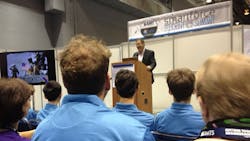CHICAGO—Today's manufacturing technology dominates the miles of exhibits vying for attention on the vast show floors of McCormick Place at this week's IMTS trade show.
Meanwhile, down in the bowels of the place, the industry's flesh-and-blood future, embodied in thousands of high school and middle school students, begin their manufacturing journey by taking part in the IMTS Smartforce Student Summit.
Down here at the summit—situated ironically in the deepest basement of the cavernous facility—the schoolkids get to play. And imagine. And dream. And hear how crucial to America's economic future their playing and imagining and dreaming are.
Smartforce keynote speaker Gregg Fleisher got things rolling Tuesday by pointing out to his student audience that it took less than 60 years for American manufacturing ingenuity to advance from the Wright Brothers' bicycle-based flying machine to a machine that could orbit the earth—and less than a decade more to create a machine that could transport human beings to the moon.
"Think about that: Sixty years to replace a wood-and-fabric airplane with a digitally controlled spacecraft," said Fleisher, chief academic officer of the National Math & Science Initiative. "That's less than a human lifetime."
"A child born when this photograph of the [Wright Brothers'] airplane was taken would have been able to watch the moon landing on a TV set—which also, by the way, wouldn't have existed when he or she was born."
Made In America
Fleisher fired off a litany of inventions that were first made by Americans: "The computer, the car, the Internet, air conditioning, calculator, telephone, iPad, dishwasher, drinking fountain, escalator, revolver, virtual reality, fiberglass, frozen foods, laser, microwave oven, refrigerator, remote control, roller coaster, oil wells, satellite communications, cat litter, sliced bread, toilet paper, bubble gum, video games."
Then he challenged the students to add to the list.
"Now it's your turn. Everyone in this room will have a role to play in our future. The future of manufacturing in America, and therefore the future of every American, depends on the ability of our students to rise to the challenges ahead of them and succeed in increasingly data-driven fields."
"That's why we at NMSI are working to ensure that skills like critical thinking and conceptual understanding are woven into STEM subjects to prepare you to face new problems and think differently in order to innovate."
The pace of technological change keeps accelerating, and today's STEM students will be well equipped to exploit those changes, Fleisher said.
"Most of the inventions I rattled off a few minutes ago were created in the 1900s," he said. "Things like the iPhone were inconceivable 20 years ago. What is unimaginable now is what you and your generation will make commonplace in the future. By pursuing STEM careers and majors, you'll be the ones who decide what the future will look like."
"Organizations like the National Math & Science Initiative exist simply to support you. We believe in you and can't wait to see what you come up with."
About the Author
Pete Fehrenbach
Pete Fehrenbach, Associate Editor
Focus: Workforce | Chemical & Energy Industries | IW Manufacturing Hall of Fame
Follow Pete on Twitter: @PFehrenbachIW
Associate editor Pete Fehrenbach covers strategies and best practices in manufacturing workforce, delivering information about compensation strategies, education and training, employee engagement and retention, and teamwork. He writes a blog about workforce issue called Team Play.
Pete also provides news and analysis about successful companies in the chemical and energy industries, including oil and gas, renewable and alternative.
In addition, Pete coordinates the IndustryWeek Manufacturing Hall of Fame, IW’s annual tribute to the most influential executives and thought leaders in U.S. manufacturing history.

